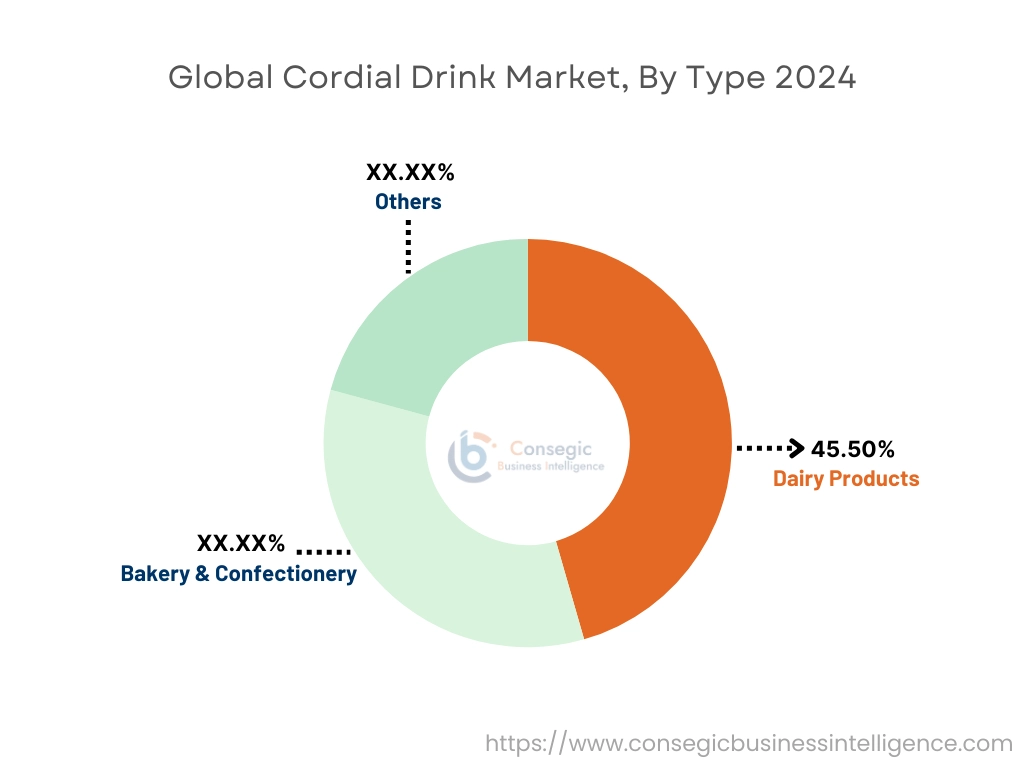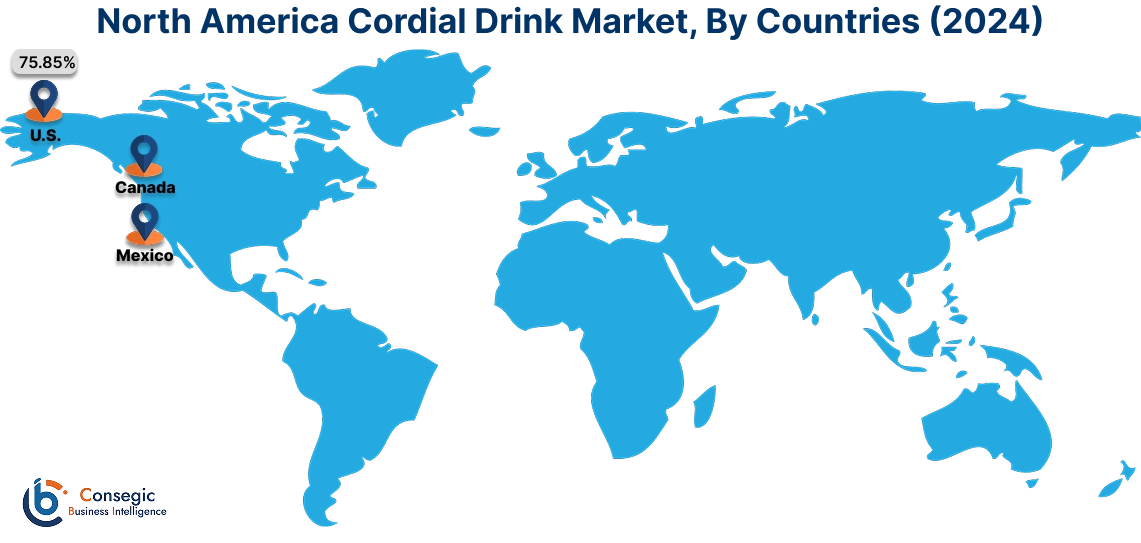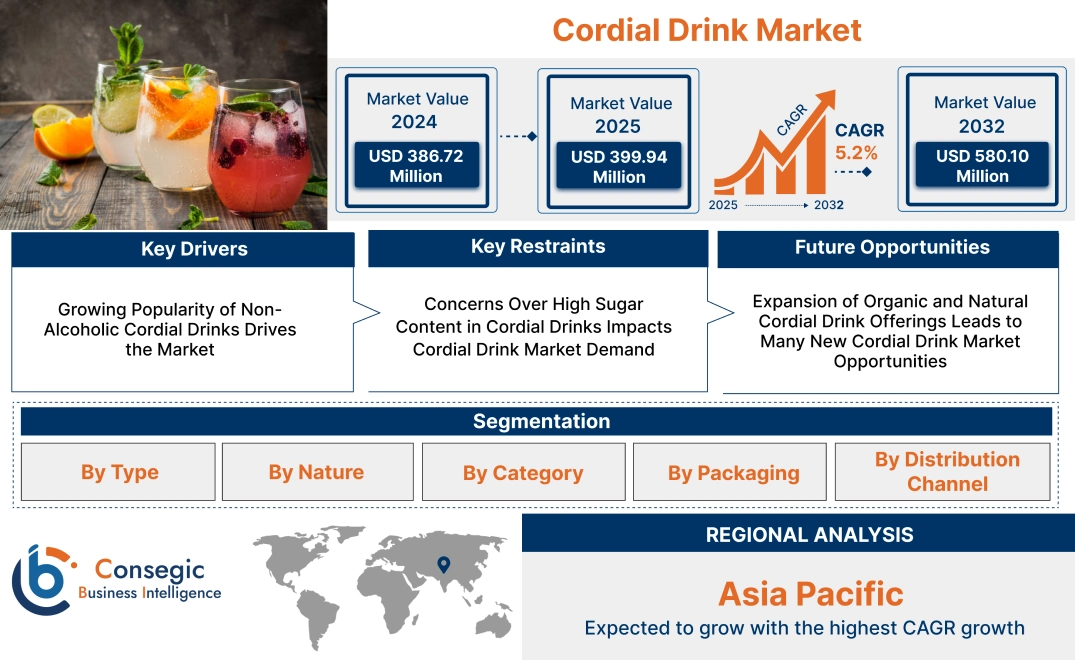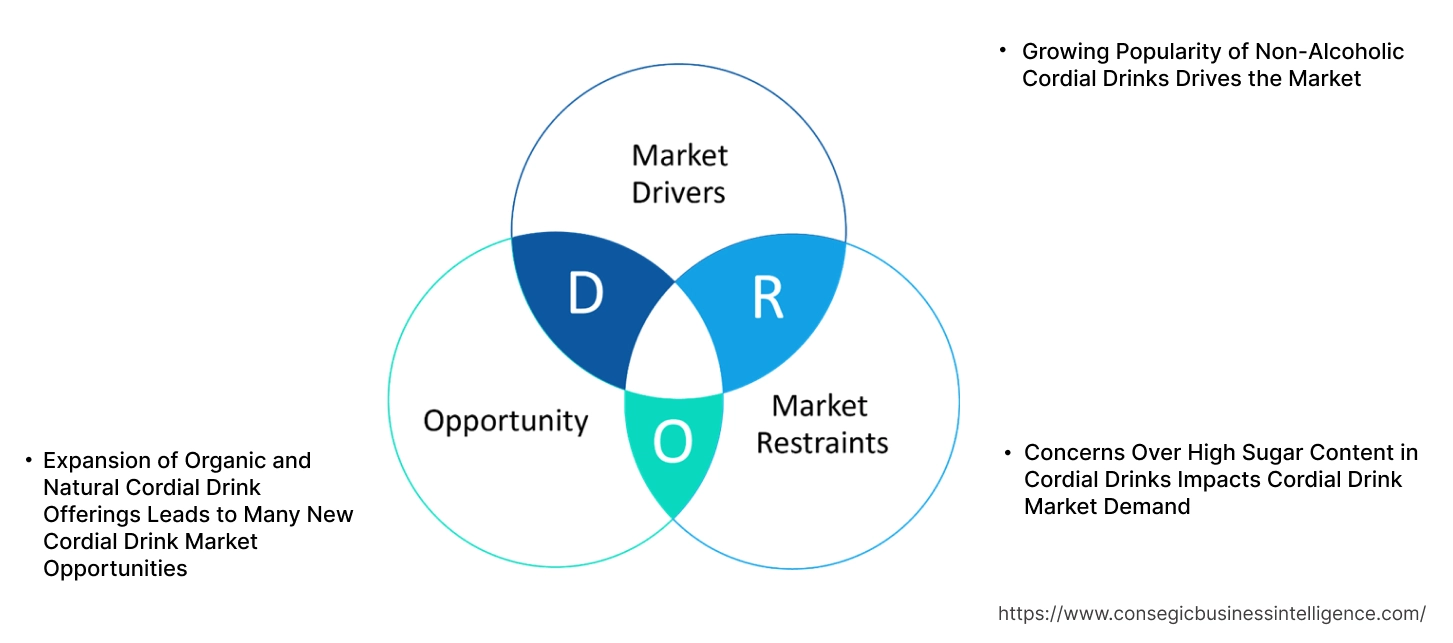- Summary
- Table Of Content
- Methodology
Cordial Drink Market Size:
Cordial Drink Market size is estimated to reach over USD 580.10 Million by 2032 from a value of USD 386.72 Million in 2024 and is projected to grow by USD 399.94 Million in 2025, growing at a CAGR of 5.2% from 2025 to 2032.
Cordial Drink Market Scope & Overview:
Cordial drink is a concentrated, non-alcoholic beverage made by blending fruit extracts, sweeteners, and flavoring agents. It is available in various flavors and formulations, including sugar-free and organic variants. Its properties include a high fruit content, extended shelf life, and easy solubility in water or other liquids. It enhances taste, provides a refreshing experience, and serves as a versatile ingredient for beverages.
These drinks are widely used in households, restaurants, and cafes. They are consumed as standalone refreshments or mixed with water, soda, or cocktails. Their ability to retain flavor and freshness makes them suitable for large-scale beverage production.
This product is essential in the food and beverage industry, catering to retail consumers, foodservice providers, and commercial beverage manufacturers. It supports the development of innovative drink formulations while meeting consumer preferences for natural and flavorful beverages.
Key Drivers:
Growing Popularity of Non-Alcoholic Cordial Drinks Drives the Market
The adoption of non-alcoholic beverages has seen a significant increase in recent years, with more consumers opting for healthier alternatives to traditional alcoholic drinks. This trend is particularly noticeable among health-conscious individuals, as well as those who seek to reduce alcohol consumption due to lifestyle choices or medical reasons. Non-alcoholic cordials are gaining traction as they offer a flavorful, refreshing option without the negative effects of alcohol. The ability to blend traditional flavors with innovative formulations in non-alcoholic cordials caters to a broad consumer base, from those seeking hydration to individuals wanting to enjoy a festive beverage without the alcohol content. For instance, non-alcoholic fruit-based cordials with natural ingredients are becoming increasingly popular in social settings as an alternative to sugary sodas or alcoholic drinks. This growing preference for non-alcoholic alternatives is directly contributing to the cordial drink market expansion, as more people look for options that align with a balanced, healthier lifestyle.
Hence, the rise in demand for non-alcoholic beverages is playing a crucial role in driving the cordial drink market growth.
Key Restraints:
Concerns Over High Sugar Content in Cordial Drinks Impacts Cordial Drink Market Demand
Despite the increasing popularity of cordial drinks, the high sugar content in many traditional recipes has raised concerns among health-conscious consumers. Excessive sugar intake is linked to a variety of health issues, including obesity, diabetes, and heart disease. As consumers become more aware of these health risks, many are turning away from products with high sugar content. The challenge for manufacturers lies in reformulating their products to meet the growing demand for healthier options, without compromising on taste. While sugar-free or low-sugar alternatives are emerging, these options often fail to replicate the traditional sweetness and flavor profiles that consumers expect. This poses a significant obstacle to the cordial drink market expansion, as the success of cordial drinks heavily relies on the balance between taste and health-conscious formulations.
In conclusion, the ongoing concern regarding sugar content limits the growth potential of the market, as companies struggle to meet consumer preferences for healthier alternatives.
Future Opportunities :
Expansion of Organic and Natural Cordial Drink Offerings Leads to Many New Cordial Drink Market Opportunities
The shift towards organic and natural products presents a significant opportunity for the market. With growing consumer interest in clean-label beverages and organic ingredients, there is potential for companies to develop and market cordials made from all-natural, sustainably sourced ingredients. This includes using organic fruits, herbs, and natural sweeteners that cater to consumers who prioritize health, sustainability, and ethical sourcing. For example, organic elderflower cordials and natural berry-based drinks are gaining popularity as consumers become more conscious of the origins of their beverages. The requirement for organic and natural products is expected to continue to rise as more people seek to incorporate holistic, wellness-oriented choices into their daily routines.
Therefore, the expanding preference for organic and natural ingredients offers a promising opportunity for companies to innovate and capture a larger share of the market in the near future.
Cordial Drink Market Segmental Analysis :
By Type:
Based on type, the market is segmented into fruit cordials, herbs & spices cordials, and vegetable cordials.
The fruit cordials sector accounted for the largest revenue in cordial drink market share by 45.50% in 2024.
- Fruit cordials are beverages made from fruit concentrates mixed with water and sugar, often with additional flavors or herbs.
- They are known for their sweet and fruity taste and are popular for refreshing beverages in both casual and formal settings.
- The increased need for natural and fresh-tasting drinks has bolstered the fruit cordial sector.
- The variety in fruit flavors, such as citrus, berry, and tropical fruits, helps attract a broad consumer base.
- Moreover, the popularity of fruit-based drinks in the health-conscious consumer segment continues to boost its market share.
- Therefore, according to cordial drink market analysis, the fruit cordials sector will continue to dominate the market due to their widespread popularity, taste appeal, and perceived health benefits, catering to a broad demographic.
The herbs & spices cordials sector is anticipated to register the fastest CAGR during the forecast period.
- Herbs & spices cordials are created by infusing herbs and spices into fruit juices or syrups, offering unique, aromatic flavors.
- They appeal to consumers seeking more sophisticated or exotic beverage options. With the growing cordial drink market demand for beverages with functional benefits, such as herbal properties promoting relaxation and digestion, this segment has attracted substantial interest.
- Their natural and less sweet profile also appeals to health-conscious individuals who prefer more subtle, complex flavors. As wellness and herbal-based drinks continue gaining popularity, the herbs & spices cordials segment is projected to experience rapid cordial drink market growth.
- Thus, according to cordial drink market analysis, the herbs & spices cordials sector is poised to see fast progress due to rising interest in unique, wellness-focused beverages, providing differentiation in the crowded cordial market.

By Nature:
Based on nature, the market is segmented into natural and artificial cordial drinks.
The natural cordial drink sector accounted for the largest revenue in cordial drink market share in 2024.
- Natural cordials use real fruit juices, herbs, and natural sweeteners to provide a pure and authentic taste.
- They are marketed as healthier alternatives to artificially flavored beverages, attracting consumers seeking natural, clean-label products.
- The cordial drink market trend toward natural ingredients is supported by increasing consumer demand for transparency in food and beverage production.
- These drinks are also positioned as environmentally friendly due to sustainable ingredient sourcing and eco-friendly production processes.
- As consumers become more health-conscious, natural cordials have seen rising adoption in both retail and hospitality sectors.
- Therefore, according to the market analysis, natural cordials are expected to remain the dominant segment due to their appeal to health-conscious and eco-aware consumers who prioritize clean, simple ingredients.
The artificial cordial drink sector is anticipated to register the fastest CAGR during the forecast period.
- Artificial cordials use synthetic flavoring and sweeteners, often priced lower than natural alternatives, attracting cost-conscious consumers.
- These products cater to a broader market by offering a wider range of flavor options at a more affordable price point.
- The affordability of artificial cordials makes them popular in regions with price-sensitive consumers.
- Despite the shift toward natural products, the affordability and extended shelf life of artificial cordials continue to support their development.
- The growing popularity of sugary drinks in certain demographics is also contributing to the rise of artificial cordial consumption.
- Thus, according to the market analysis, the artificial cordial sector is expected to see the fastest growth as a result of its affordability, variety, and extended shelf life, especially in emerging markets.
By Category:
Based on category, the market is segmented into sugar-based and sugar-free.
The sugar-based cordial drink sector accounted for the largest revenue share in 2024.
- Sugar-based cordials are traditional drinks that contain added sugars or sweeteners, making them highly palatable to a wide range of consumers.
- These drinks are known for their rich, sweet taste and are commonly used in cocktails, mocktails, and as stand-alone beverages.
- While there is a growing demand for healthier options, sugar-based cordials maintain strong appeal due to their indulgent flavors and versatility in mixology.
- In many regions, sugar-based cordials remain a staple in both home and commercial beverage settings. The wide availability of sugar-based options across various retail outlets helps drive their market dominance.
- Therefore, according to the market analysis, sugar-based cordials are expected to continue holding the largest market share, driven by their established popularity and versatile applications.
The sugar-free cordial drink sector is anticipated to register the fastest CAGR during the forecast period.
- Sugar-free cordials cater to the growing segment of consumers who are focused on reducing their sugar intake due to health concerns like diabetes and obesity.
- These products use artificial sweeteners or natural sugar substitutes to maintain sweetness without the associated caloric content.
- As the trend for low-sugar, healthy alternatives continues, the requirement for sugar-free cordials is accelerating.
- Sugar-free options appeal not only to health-conscious individuals but also to those following specific diets such as keto or low-carb.
- With increasing awareness about the health risks of excessive sugar consumption, sugar-free cordials are expected to see substantial market development.
- Thus, according to the market analysis, sugar-free cordials are projected to experience the fastest growth due to the increasing consumer shift toward healthier, low-sugar options.
By Packaging:
Based on packaging, the market is segmented into bottled, canned, and pouches.
The bottled cordial drink sector accounted for the largest revenue share in 2024.
- Bottled cordials are popular due to their convenience, portability, and ability to preserve the flavor and freshness of the drink.
- These products are widely available in various retail outlets, including supermarkets, and are favored for their visual appeal and brand recognition.
- Bottled cordials often have premium packaging that enhances their shelf appeal, making them more attractive to consumers seeking high-quality products.
- Additionally, the glass bottle packaging is preferred by many for its sustainability and the perception of a high-end product. Bottled cordial drinks are a staple in both retail and hospitality sectors, particularly in upscale settings.
- Therefore, according to the market analysis, bottled cordials are expected to maintain their dominant position due to their established popularity and premium market appeal.
The pouch sector is anticipated to register the fastest CAGR during the forecast period.
- Pouches are increasingly popular due to their convenience, portability, and lower cost compared to other packaging types.
- They are commonly used for on-the-go consumption, making them ideal for the growing cordial drink market trend of convenience-focused products.
- Additionally, pouches are seen as more eco-friendly compared to plastic bottles or cans, which is appealing to environmentally conscious consumers.
- The lightweight nature of pouches allows for easy transportation and storage, making them a preferred choice for both consumers and distributors.
- As pouch packaging becomes more versatile, offering resealable and spill-proof features, its popularity is expected to continue rising.
- Therefore, according to the market analysis, pouches are set to experience the fastest development as a result of their convenience, cost-effectiveness, and environmental appeal.
By Distribution Channel:
Based on distribution channel, the market is segmented into supermarkets & hypermarkets, departmental stores, and online retail.
The supermarkets & hypermarkets sector accounted for the largest revenue share in 2024.
- Supermarkets and hypermarkets are the primary distribution channels for cordial drinks, offering a wide variety of brands and product types.
- These large-scale retail outlets provide consumers with easy access to cordials in various flavors and packaging options.
- The ability to buy in bulk, along with discounts and promotions, makes supermarkets and hypermarkets a go-to shopping destination for cordial drink consumers.
- Moreover, the large store formats enable retailers to display a broad selection of products, driving higher foot traffic and increased sales.
- Supermarkets and hypermarkets remain dominant due to their established infrastructure and consistent consumer traffic.
- Therefore, according to the market analysis, supermarkets and hypermarkets will continue to dominate due to their comprehensive product offerings and consumer convenience.
The online retail sector is anticipated to register the fastest CAGR during the forecast period.
- Online retail channels are increasingly popular due to the growing trend of e-commerce and home delivery services.
- The convenience of shopping from home, along with the ability to easily compare prices, has made online shopping a preferred option for many consumers.
- Moreover, the availability of a wider variety of cordials and the ability to access products from different regions contribute to the rise of online retail.
- The rise in smartphone usage and online payment solutions has also contributed to the growth of online retail in the market.
- As online platforms continue to enhance their customer experience with faster delivery times and better services, the online retail sector is expected to experience substantial development.
- Therefore, according to the market analysis, online retail is projected to experience the fastest growth, driven by increasing consumer preference for the convenience and variety it offers.
Regional Analysis:
The regional segment includes North America, Europe, Asia Pacific, Middle East and Africa, and Latin America.

In 2024, North America was valued at USD 128.28 Million and is expected to reach USD 188.01 Million in 2032. In North America, the U.S. accounted for the highest share of 75.85% during the base year of 2024.
In North America, the cordial drink market is experiencing steady demand, with the United States and Canada as key contributors. The increasing popularity of premium and flavored beverages, along with a rising inclination toward non-alcoholic alternatives, supports market performance. The growing trend of health-conscious consumers is influencing manufacturers to offer low-sugar and natural ingredient options. Additionally, the expanding cocktail culture and the use of cordials in mixology provide opportunities for progress in the region.

In Asia Pacific, the market is experiencing the fastest growth with a CAGR of 5.6% over the forecast period.
Asia-Pacific is seeing significant expansion in the cordial drink market, driven by rapidly developing economies like China and India. Rising disposable incomes, urbanization, and the growing adoption of westernized drinking habits contribute to increased consumption of cordial drinks. The region’s young population is particularly drawn to innovative flavors and convenience, making cordial drinks increasingly popular. Additionally, as the region's food and beverage industry continues to grow, the adoption of both alcoholic and non-alcoholic cordials is rising.
In Europe, the cordial drink market is well-established with a strong presence in countries like the United Kingdom, Germany, and France. The tradition of cordial consumption in the region is well-integrated into both culinary and social practices. The rising demand for flavored and specialty drinks, along with increased awareness of quality ingredients, is fueling market progress. Additionally, the region's focus on premium and craft beverages is creating opportunities for product diversification, especially in alcoholic cordial drinks.
The Middle East and Africa (MEA) market for cordial drinks is growing, with demand largely driven by the preference for sweet, flavored beverages in countries like Saudi Arabia, the UAE, and South Africa. The rising disposable income and a growing population in urban areas contribute to higher consumption levels. However, traditional beverage preferences may limit the market potential in certain regions. Manufacturers are exploring opportunities to introduce innovative cordial drinks to cater to evolving tastes and trends in the MEA region.
In Latin America, countries like Brazil and Mexico show strong potential in the cordial drink market. Cordials are popular in the region for both casual and celebratory occasions. A rising middle class and increased urbanization are driving need for a variety of beverage options. Local flavors and ingredients are gaining traction, with consumers seeking unique and regionally-inspired cordial offerings. While the market is influenced by economic fluctuations, the need for refreshing and affordable beverages remains strong in the region.
Top Key Players & Market Share Insights:
The global cordial drink market is highly competitive with major players providing products and services to the national and international markets. Key players are adopting several strategies in research and development (R&D), product innovation, and end-user launches to hold a strong position in the Global Cordial Drink Market. Key players in the Cordial Drink industry include-
- Rasna Pvt Limited (India)
- Britvic PLC (United Kingdom)
- Nestlé S.A. (Switzerland)
- Red Bull GmbH (Austria)
- Monster Beverage Corporation (United States)
- AG Barr plc (United Kingdom)
- PepsiCo, Inc. (United States)
- The Coca-Cola Company (United States)
- Unilever PLC (United Kingdom)
- Kraft Heinz Company (United States)
Recent Industry Developments :
Product Launches:
- In February 2025, Celsius, known for its energy drinks, expanded into the wellness beverage category with the introduction of Celsius Hydration. This caffeine-free product is designed to replenish electrolytes and is available in five fruity flavors: Fruit Punch, Blue Razz, Strawberry Watermelon, Arctic Cherry, and Lemon Lime. Each box contains 14 packets priced at $12.99, offering a competitively priced option in the hydration market.
Partnerships & Collaborations:
- In March 2024, British soft drinks brand Bottlegreen partnered with Edwards 1902 to launch a trio of vodka-based spritzes. The new products, available in Elderflower, Raspberry, and Lime & Mint flavors, combine Bottlegreen's cordials with Edwards 1902's English vodka, catering to consumers seeking innovative and flavorful beverage options.
Mergers and Acquisitions:
- In January 2025, Molson Coors acquired an 8.5% stake in Fevertree Drinks for £71 million, securing exclusive rights to market Fevertree's cocktail mixers, tonic water, and ginger beers in the U.S. This move aims to diversify Molson Coors' non-alcoholic beverage offerings amid declining beer sales.
- In December 2024, Coca-Cola acquired Billson’s, a Beechworth-based drinks manufacturer, allowing it to expand its alcoholic ready-to-drink range in Australia. The acquisition enables Billson’s owners to continue producing their products under a new brand and structure while maintaining their hospitality business.
- In December 2024, Supreme, known for its vape and drinks products, acquired the century-old Typhoo Tea for £10.2 million after the tea company entered administration due to unsustainable debts and declining sales. Supreme aims to leverage its market reach and shift focus from vaping to its drinks and nutrition operations.
Cordial Drink Market Report Insights:
| Report Attributes | Report Details |
| Study Timeline | 2019-2032 |
| Market Size in 2032 | USD 580.10 Million |
| CAGR (2025-2032) | 5.2% |
| By Type |
|
| By Nature |
|
| By Category |
|
| By Packaging |
|
| By Distribution Channel |
|
| By Region |
|
| Key Players |
|
| North America | U.S. Canada Mexico |
| Europe | U.K. Germany France Spain Italy Russia Benelux Rest of Europe |
| APAC | China South Korea Japan India Australia ASEAN Rest of Asia-Pacific |
| Middle East and Africa | GCC Turkey South Africa Rest of MEA |
| LATAM | Brazil Argentina Chile Rest of LATAM |
| Report Coverage |
|
Key Questions Answered in the Report
How big is the Cordial Drink Market? +
In 2024, the Cordial Drink Market was USD 386.72 million.
What will be the potential market valuation for the Cordial Drink Market by 2032? +
In 2032, the market size of Cordial Drink Market is expected to reach USD 580.10 million.
What are the segments covered in the Cordial Drink Market report? +
The type, nature, category, packaging, and distribution channel are the segments covered in this report.
Who are the major players in the Cordial Drink Market? +
Rasna Pvt Limited (India), Britvic PLC (United Kingdom), AG Barr plc (United Kingdom), PepsiCo, Inc. (United States), The Coca-Cola Company (United States), Unilever PLC (United Kingdom), Kraft Heinz Company (United States), Nestlé S.A. (Switzerland), Red Bull GmbH (Austria), Monster Beverage Corporation (United States) are the major players in the Cordial Drink market.


